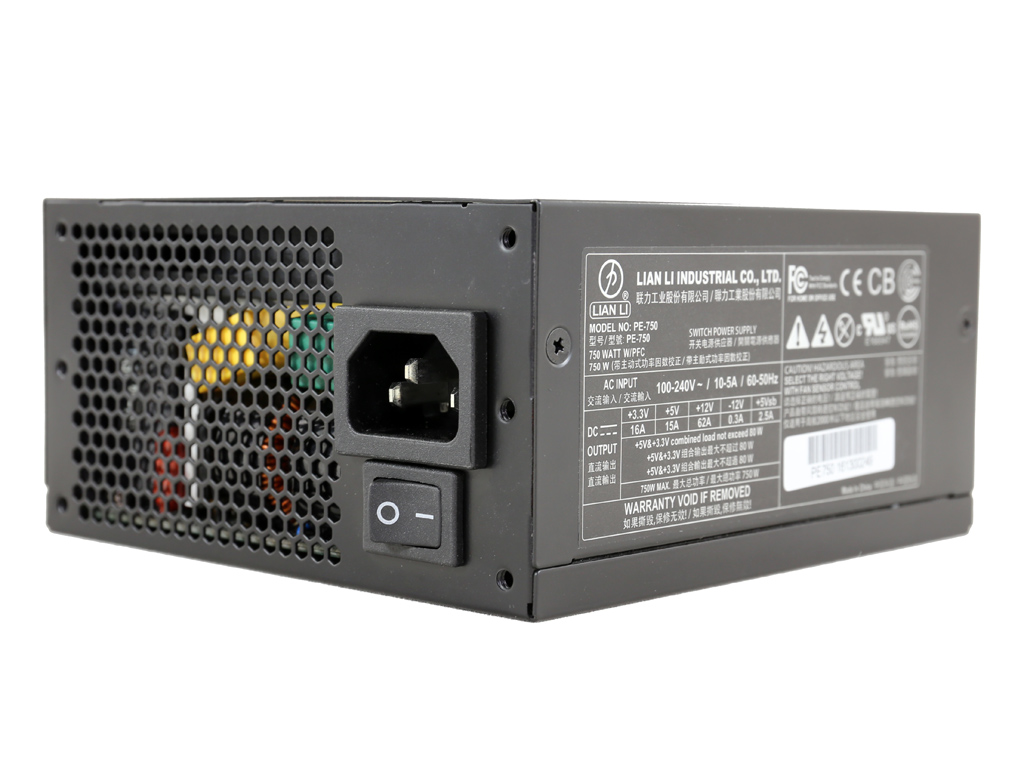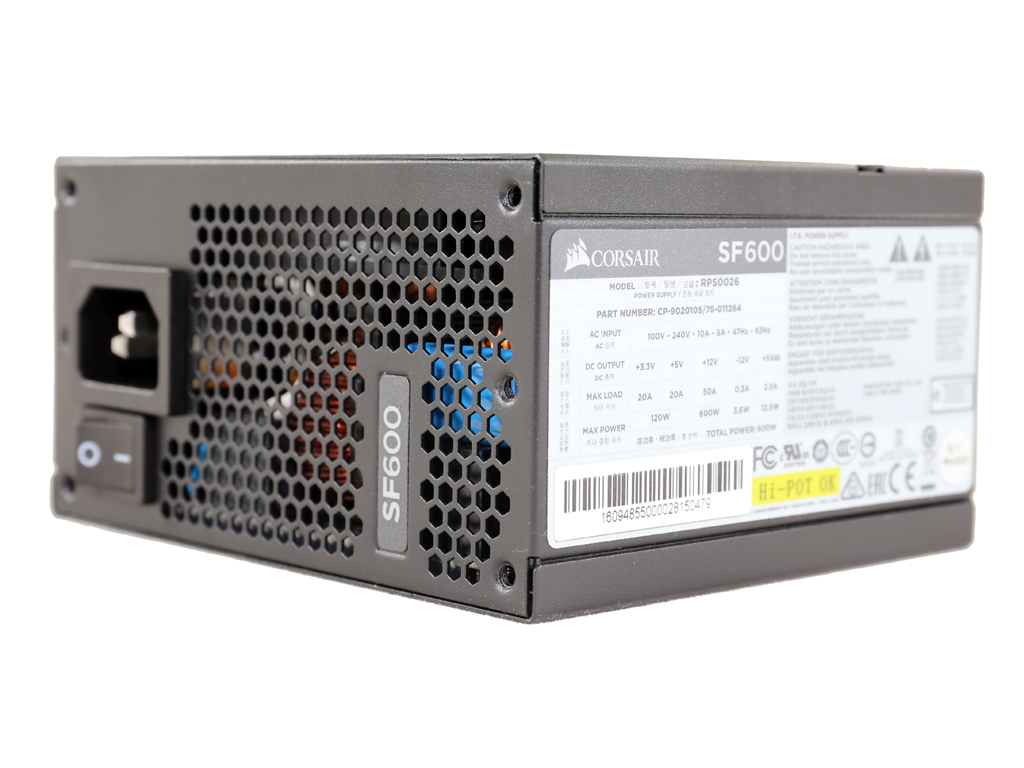Lian Li PE-750 SFX-L 750W PSU Review
Lian Li enters the PSU market again with two new SFX-L models featuring 550 W and 750 W capacities. The PE-750 is under the microscope today. It features modular cabling, a single +12V rail, and a semi-passive fan.
Why you can trust Tom's Hardware
Load Regulation, Hold-Up Time, And Inrush Current
To learn more about our PSU tests and methodology, please check out How We Test Power Supply Units.
Primary Rails And 5VSB Load Regulation
Load Regulation testing is detailed here.

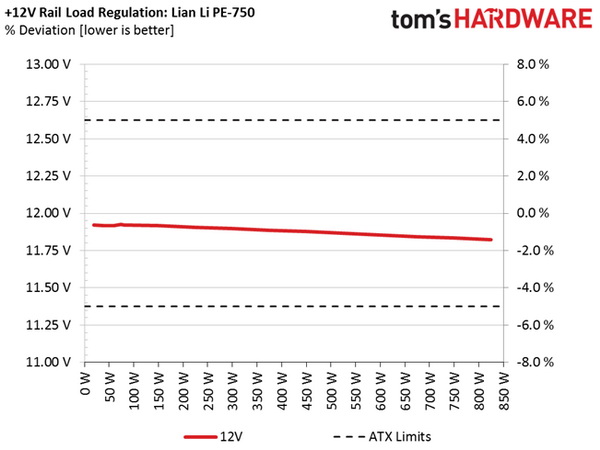
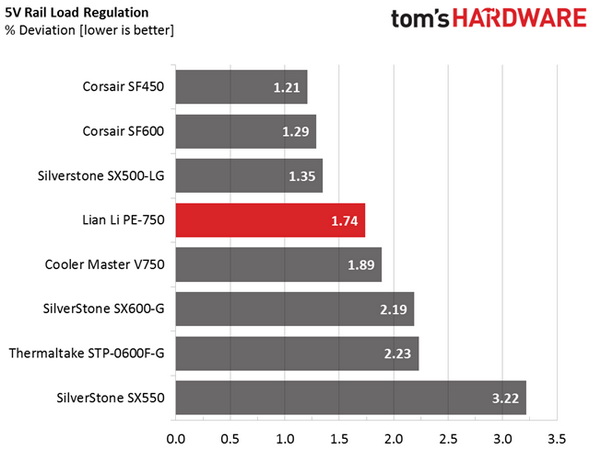
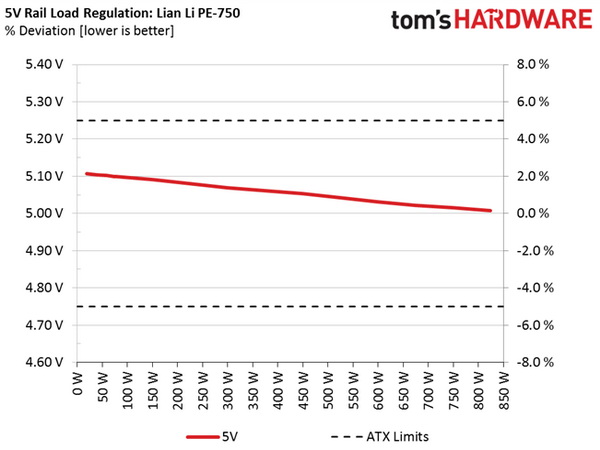
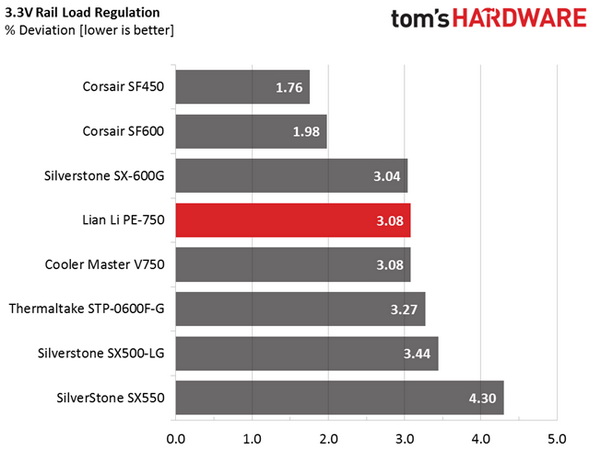
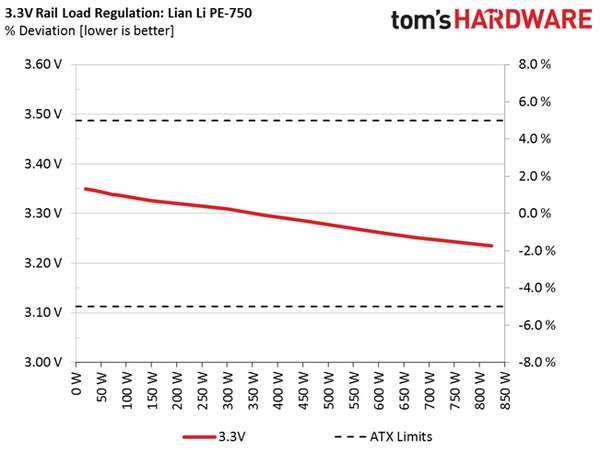
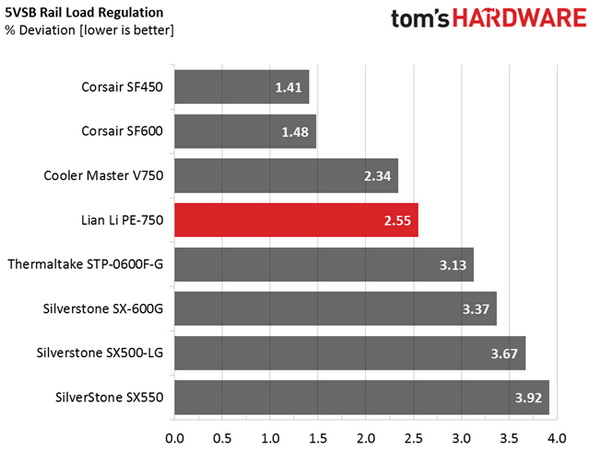
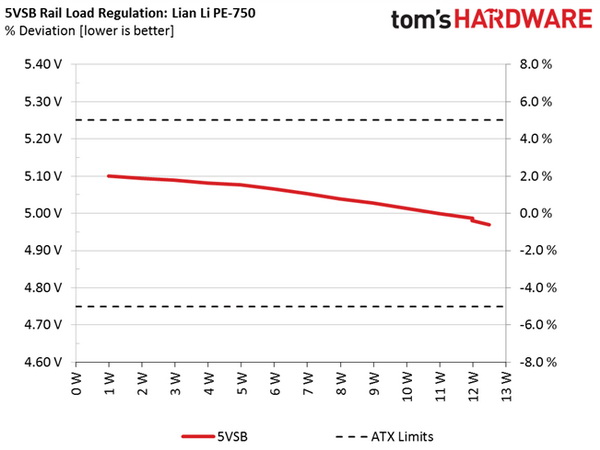
Hold-Up Time
Our hold-up time tests are described in detail here.
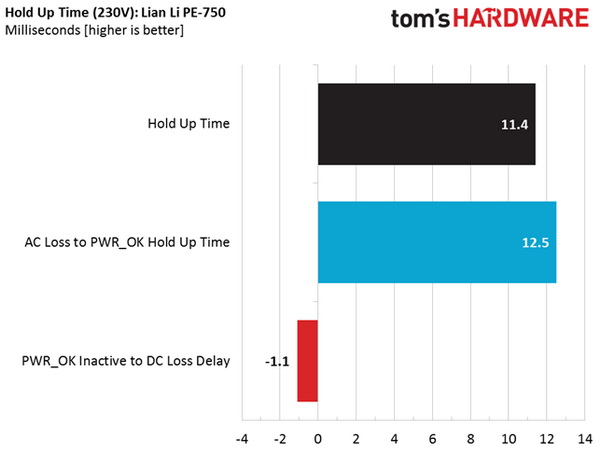



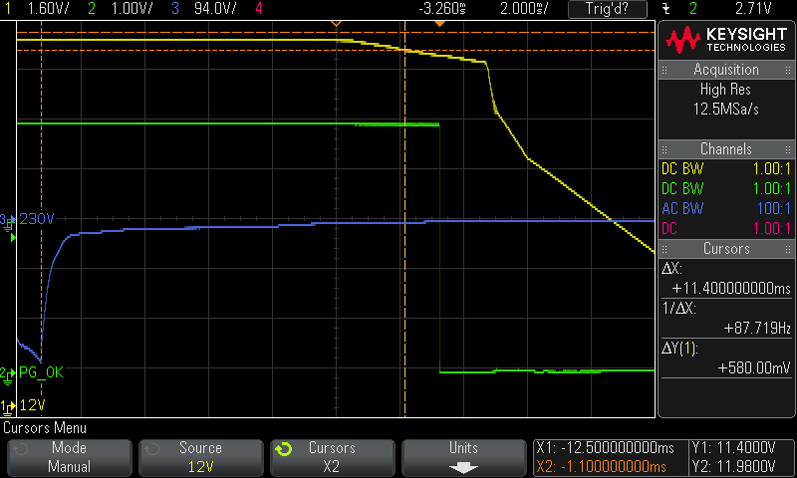
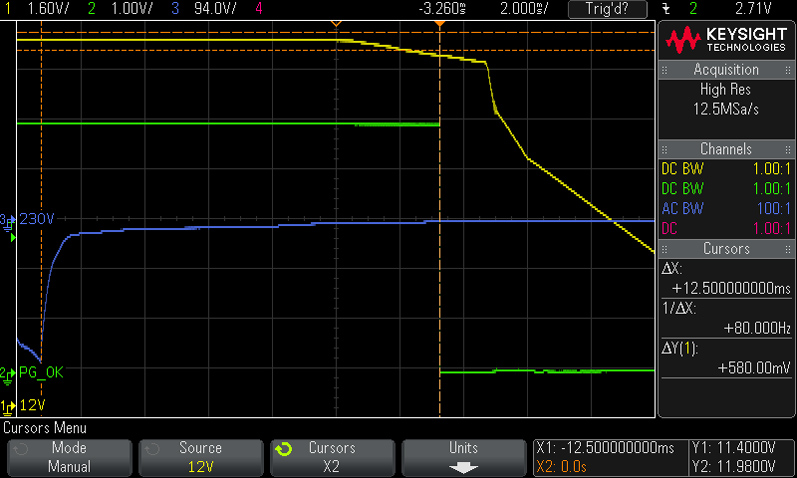
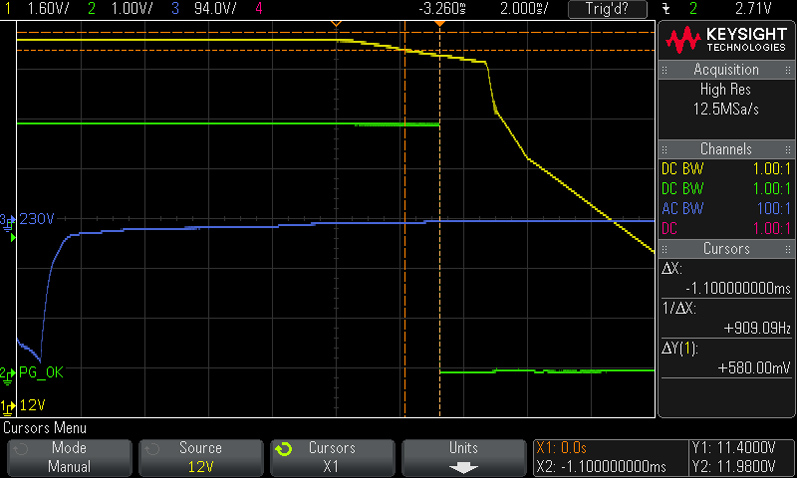
The hold-up time is low, though that's not the only problem. Lian Li's power-good signal lasts longer than the actual hold-up time. In other words, the PSU sends a power-good signal to the system even after its rails are out of spec.
Thankfully, the delay between power-good dropping and the moment the rails go out of spec is small at just 1.1 ms. Obviously, larger bulk caps are needed to lengthen the hold-up time.
Inrush Current
For details on our inrush current testing, please click here.
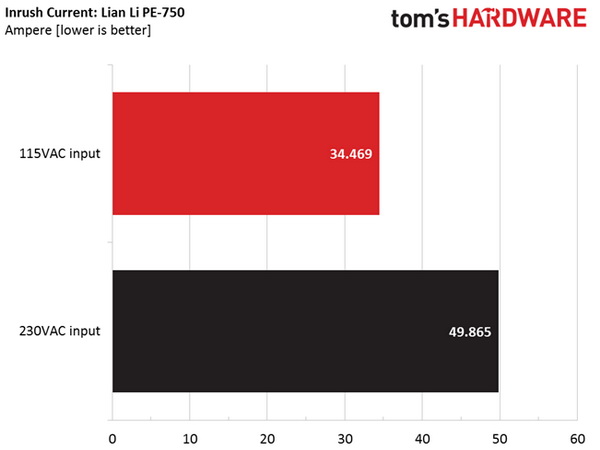
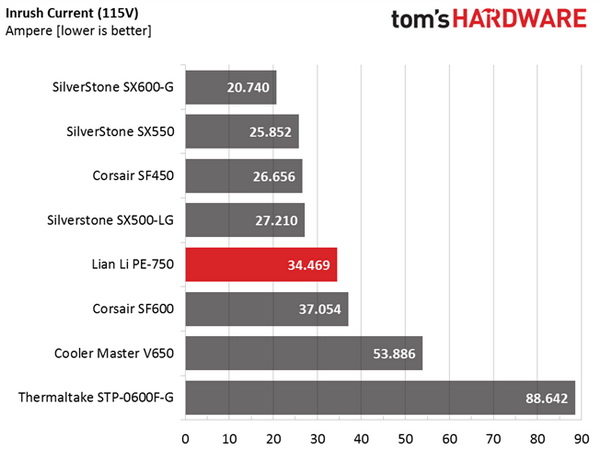
The inrush current lands where we'd expect it.
Get Tom's Hardware's best news and in-depth reviews, straight to your inbox.
Load Regulation And Efficiency Measurements
The first set of tests reveals the stability of the voltage rails and the PSU's efficiency. The applied load equals (approximately) 10 to 110 percent of the maximum load the supply can handle, in increments of 10 percentage points.
We conducted two additional tests. During the first, we stressed the two minor rails (5V and 3.3V) with a high load, while the load at +12V was only 0.1 A. This test reveals whether a PSU is Haswell-ready or not. In the second test, we determined the maximum load the +12V rail could handle with minimal load on the minor rails.
| Test # | 12V | 5V | 3.3V | 5VSB | DC/AC (Watts) | Efficiency | Fan Speed | Fan Noise | Temps (In/Out) | PF/AC Volts |
|---|---|---|---|---|---|---|---|---|---|---|
| 1 | 4.458A | 1.965A | 1.974A | 0.981A | 74.75 | 90.67% | 0 RPM | 0 dB(A) | 42.48 °C | 0.934 |
| 11.925V | 5.099V | 3.338V | 5.077V | 82.44 | 40.51 °C | 115.1V | ||||
| 2 | 9.973A | 2.939A | 2.974A | 1.180A | 149.67 | 93.46% | 0 RPM | 0 dB(A) | 44.12 °C | 0.962 |
| 11.916V | 5.091V | 3.326V | 5.066V | 160.15 | 41.53 °C | 115.1V | ||||
| 3 | 15.853A | 3.446A | 3.494A | 1.383A | 224.85 | 93.39% | 820 RPM | 26.1 dB(A) | 41.50 °C | 0.978 |
| 11.907V | 5.080V | 3.318V | 5.053V | 240.76 | 45.88 °C | 115.1V | ||||
| 4 | 21.733A | 3.943A | 3.987A | 1.585A | 299.72 | 93.06% | 1055 RPM | 31.8 dB(A) | 41.70 °C | 0.982 |
| 11.897V | 5.069V | 3.309V | 5.039V | 322.08 | 46.40 °C | 115.1V | ||||
| 5 | 27.277A | 4.941A | 5.002A | 1.787A | 374.69 | 92.51% | 1055 RPM | 31.8 dB(A) | 41.98 °C | 0.986 |
| 11.886V | 5.061V | 3.296V | 5.028V | 405.01 | 46.99 °C | 115.1V | ||||
| 6 | 32.824A | 5.934A | 6.023A | 1.989A | 449.60 | 91.07% | 1735 RPM | 42.7 dB(A) | 43.97 °C | 0.988 |
| 11.877V | 5.053V | 3.286V | 5.014V | 493.67 | 49.58 °C | 115.1V | ||||
| 7 | 38.385A | 6.946A | 7.053A | 2.196A | 524.57 | 90.07% | 1910 RPM | 45.3 dB(A) | 44.33 °C | 0.991 |
| 11.866V | 5.042V | 3.274V | 5.000V | 582.43 | 50.33 °C | 115.1V | ||||
| 8 | 43.957A | 7.950A | 8.091A | 2.404A | 599.53 | 89.24% | 2155 RPM | 49.8 dB(A) | 45.03 °C | 0.993 |
| 11.856V | 5.031V | 3.262V | 4.987V | 671.82 | 51.48 °C | 115.1V | ||||
| 9 | 49.984A | 8.470A | 8.641A | 2.406A | 674.62 | 88.46% | 2205 RPM | 50.0 dB(A) | 45.19 °C | 0.994 |
| 11.844V | 5.022V | 3.251V | 4.981V | 762.67 | 51.96 °C | 115.1V | ||||
| 10 | 55.967A | 8.979A | 9.159A | 2.512A | 749.47 | 87.65% | 2220 RPM | 50.1 dB(A) | 45.54 °C | 0.995 |
| 11.833V | 5.015V | 3.243V | 4.970V | 855.03 | 52.74 °C | 115.1V | ||||
| 11 | 62.348A | 8.994A | 9.180A | 2.515A | 824.36 | 86.88% | 2220 RPM | 50.1 dB(A) | 46.07 °C | 0.996 |
| 11.823V | 5.007V | 3.235V | 4.964V | 948.90 | 53.62 °C | 115.1V | ||||
| CL1 | 0.101A | 10.011A | 10.005A | 0.000A | 85.04 | 84.87% | 1910 RPM | 45.3 dB(A) | 44.31 °C | 0.945 |
| 11.924V | 5.076V | 3.300V | 5.106V | 100.20 | 49.82 °C | 115.1V | ||||
| CL2 | 61.937A | 1.003A | 1.003A | 1.000A | 746.69 | 88.26% | 2220 RPM | 50.1 dB(A) | 45.56 °C | 0.995 |
| 11.840V | 5.036V | 3.281V | 5.014V | 846.01 | 52.71 °C | 115.1V |
The +12V rail's load regulation is pretty tight, while the 5V rail also fares well. The 3.3V rail isn't as strong; it registers greater-than 3 percent deviation.
We measure very high efficiency in the 20 percent and 50 percent load tests, though under full load it lands far from the 80 PLUS Platinum certification's 89 percent threshold. Then again, we push the PSUs we test hard with ambient temperatures in excess of 45 °C. The 80 PLUS organization uses much more forgiving conditions.
Despite high temperatures inside our box, the PE-750 operates passively up to the 20 percent load test. Even at 50 percent, the fan's noise is low. But after that it accelerates quickly, reaching 50 dB(A) during the 90 percent to 110 percent load tests. Apparently, the fan profile gets aggressive under harsh operating conditions. If Lian Li used an FDB fan instead, our noise readings might have been lower. And with such a large heat sink on the primary side, we think the fan profile could be relaxed a bit.
Current page: Load Regulation, Hold-Up Time, And Inrush Current
Prev Page A Look Inside And Component Analysis Next Page Efficiency, Temperature, And Noise
Aris Mpitziopoulos is a contributing editor at Tom's Hardware, covering PSUs.
-
Aris_Mp For the SFX-L standards actually it is quite good. There is next to zero competition in this field. With a few part changes this platform has potential, however I don't know if it could keep efficiency at the same high levels.Reply -
shrapnel_indie Lian Li is supposed to be a premium brand. Just look how expensive (and the usual quality of) their cases are when you can find them. By the numbers and its internals, this doesn't look like a premium brand product, regardless of how much or how little competition they got in a given market.Reply
Lian Li, have you decided to no longer be a true premium brand? -
Valantar Definitely disappointing. Looks like Lian Li is going for the "money to burn, don't care" market. This PSU had amazing promise, but the choice of fan, the too-small caps and the short warranty make this unbuyable. Now, I don't have empirical data to base this on, but I'd guess most people springing $160 on a PSU - SFX or not - want it to last more than 2-3 years. And using a fan that's both short-lived _and_ unsuitable for horizontal mounting? That's just idiotic.Reply -
Virtual_Singularity Solid review, as always, great job Aris. Even if this isn't an ideal psu, Lian Li is a quality brand, a quality case brand. However, its worth noting that of the ample (edit: particularly sfx/sfxl) PSU's Enhance has OEM'd for various brands, this one has to be among the best of them. Even if Lian Li introduced an absolutely horrible psu, wouldn't matter much to their fans, its the quality they put into many of their cases that's most important. Even if they cave more than they already have to the recent case trends, I hope they still keep producing no nonsense cases for that niche market that still values them.Reply -
Valantar Reply18666014 said:Solid review, as always, great job Aris. Even if this isn't an ideal psu, Lian Li is a quality brand, a quality case brand. However, its worth noting that of the ample PSU's Enhance has OEM'd for various brands, this one has to be among the best of them. Even if Lian Li introduced an absolutely horrible psu, wouldn't matter much to their fans, its the quality they put into many of their cases that's most important. Even if they cave more than they already have to the recent case trends, I hope they still keep producing no nonsense cases for that niche market that still values them.
Sure, Lian Li makes great cases (although IMHO they too often screw up their nice minimalist looks with unnecessary clutter, and they're way behind the times in a few usability/ease of build areas today). But how does this relate to this PSU? In no way at all. Lian Li might be "a quality brand, a quality case brand", but that does nothing to change the fact that this is a premium priced PSU built with mind-boggling cost cutting in key areas, making its lifetime radically shorter than it should be. This would barely be okay for a $60 PSU. For a $160 unit, it's not only a deal breaker, it's about on the same level as the engineers shouting "F*ck you!" to every individual buyer. -
Virtual_Singularity Reply18670375 said:18666014 said:Solid review, as always, great job Aris. Even if this isn't an ideal psu, Lian Li is a quality brand, a quality case brand. However, its worth noting that of the ample PSU's Enhance has OEM'd for various brands, this one has to be among the best of them. Even if Lian Li introduced an absolutely horrible psu, wouldn't matter much to their fans, its the quality they put into many of their cases that's most important. Even if they cave more than they already have to the recent case trends, I hope they still keep producing no nonsense cases for that niche market that still values them.
Sure, Lian Li makes great cases (although IMHO they too often screw up their nice minimalist looks with unnecessary clutter, and they're way behind the times in a few usability/ease of build areas today). But how does this relate to this PSU? In no way at all. Lian Li might be "a quality brand, a quality case brand", but that does nothing to change the fact that this is a premium priced PSU built with mind-boggling cost cutting in key areas, making its lifetime radically shorter than it should be. This would barely be okay for a $60 PSU. For a $160 unit, it's not only a deal breaker, it's about on the same level as the engineers shouting "F*ck you!" to every individual buyer.
Fwiw, I've no need of this form factor in a psu, so I'm really not bothered by it so much. But take the comment Aris made above into account. TBH, it'd be very easy to come to your conclusion if not for this psu being in the SFXL category. It really is one of the better ones I've seen reviewed, despite the short warranty. A shorter warranty is typical of the latest comparable units, (Silverstone, for example, has 2-3 years depending on location) the exception being Corsair, possibly. I say possibly because I don't know how their latest sfx units, despite having a longer warranty, compare with this one in overall efficiency, performance. and size.
The latest platinum/titanium rated SFX/SFX-L units carry a price premium. For those demanding a sfx-l unit, the one reviewed above is among the best performers, regardless of it's short warranty. -
blazorthon Problem is that it has multiple issues that are not inherent of being a smaller form factor such as SFX. Lian Li could have simply used a better, same-sized fan. There is also enough room for better caps. Being expensive just because of its efficiency with no regard for long-term reliability is idiotic and contradictory to being a high-end PSU in the first place.Reply -
gadgety Great to highlight the weaknesses of this PSU. How does it compare to the Silverstone SX700-LPT? Which one is best. Do a shootout, or do an comparison piece.Reply
